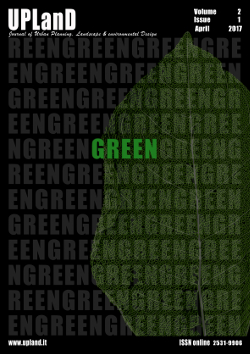transPLANTing Heat island Effects in Tokyo
Main Article Content
Abstract
This research documents recent outcomes set forth by the Guidelines for Heat Island Control Measures (GHICM) in 2005 by the Bureau of the Environment, Tokyo Metropolitan Government. These guidelines incentivized development in general to implement such techniques as green roof, living wall and water-retaining pavements as intensive heat island control measures in the central urban core of Tokyo. The original research findings of this paper stem from a 2016 Snell Endowment for Transportation Research grant intended to disseminate such metrics as methodology for future transportation development, specifically focused on transportation infrastructure’s adaptation of the GHICM and the implementation of living wall systems. This study qualitatively documents three living wall systems in transportation infrastructure design in the most intense heat areas defined by the GHICM: JR Tokyo Train Station Drop-off, Ookayama Station/Hospital and Ginza Station terrace. Ultimately, this comparative research facilitates transportation infrastructure optimization, novel implementation of green building techniques and heat-island reduction through physical and cultural potentials.
Downloads
Download data is not yet available.
Article Details
How to Cite
BriscoeD. (2017). transPLANTing Heat island Effects in Tokyo. UPLanD - Journal of Urban Planning, Landscape & Environmental Design, 2(1), 153-163. https://doi.org/10.6093/2531-9906/5145
Issue
Section
Articles

This work is licensed under a Creative Commons Attribution-NonCommercial-NoDerivatives 4.0 International License.
Authors who publish with this journal agree to the following terms:- Authors retain copyright and grant the journal right of first publication with the work simultaneously licensed under a Creative Commons Attribution License that allows others to share the work with an acknowledgement of the work's authorship and initial publication in this journal.
- Authors are able to enter into separate, additional contractual arrangements for the non-exclusive distribution of the journal's published version of the work (e.g., post it to an institutional repository or publish it in a book), with an acknowledgement of its initial publication in this journal.
- Authors are permitted and encouraged to post their work online (e.g., in institutional repositories or on their website) prior to and during the submission process, as it can lead to productive exchanges, as well as earlier and greater citation of published work (See The Effect of Open Access).
References
Braiterman, J. (2010). Tokyu Hospital covered in vines and plants. Retrieved from https://tokyogreenspace.com /2010/08/10/ tokyu-hospital-covered-in-vines-and-plants/.
Briscoe, D. & Simmons, M. (2013). Green Wall Project. Fourth Annual Sustainability Symposium in the Best of Research and Initiatives, University of Texas at Austin, September 20, 2013.
Briscoe, D. (2016) Site visit to Tokyo for field research, Interview with Yuk Matsuzaki July 22, 2016 at 10am.
Charoenkit, S. & Yiemwattana, S. (2016) Living walls and their contribution to improved thermal comfort and carbon emission reduction: A review. Building and Environment 105, 82-94. doi: 10.1016/j.buildenv.2016.05.031.
Freedman, A. (2010). Tokyo in Transit: Japanese Culture on the Rails and Road. Palo Alto, CA: Stanford University Press.
Guidelines for Heat Island Control Measures [Summary Edition, July, 2005] Bureau of the Environment, Tokyo Metropolitan Government, Tokyo Metropolitan Government Bureau of the Environment. Retrieved from http://www2.kankyo.metro.tokyo.jp/heat/
Largo-Wight, E. (2011) Cultivating healthy places and communities: evidenced-based nature contact recommendations. International Journal of Environmental Health Research Vol. 21, Issue. 1.
doi: 10.1080/09603123.2010.499452.
Fowdar, H. S., & et al (2017) Designing living walls for greywater treatment. Water Research 110, 218-232. doi: 10.1016/j.watres.2016.12.018.
Pojani, D. & Stead, D. (2015) Sustainable Urban Transport in the Developing World: Beyond Megacities. Sustainability 2015, 7, 7784-7805.
Van Uffelen, C. (2011) Façade Greenery: Contemporary Landscaping. Salenstein, CH: Braun Publishing AG.
Vaughan, P. (2014) Tokyo's Heuchera Rainbow Wall Thriving with Terra Nova Nursery. Retrieved from http://www.totallandscapecare.com/green-industry-news/tokyos-heuchera-rainbow-wall-thriving-with-terra-nova-nursery-bred-varieties/#sthash.HXQQBmdM.dpuf.
Victorero, F. Et.al. (2015) Experimental study of the thermal performance of living walls under semiarid climatic conditions. 6th International Building Physics Conference Proceedings, Energy Procedia 78 (2015) 3416 – 3421. doi: 10.1016/j.egypro.2015.12.160.
Briscoe, D. & Simmons, M. (2013). Green Wall Project. Fourth Annual Sustainability Symposium in the Best of Research and Initiatives, University of Texas at Austin, September 20, 2013.
Briscoe, D. (2016) Site visit to Tokyo for field research, Interview with Yuk Matsuzaki July 22, 2016 at 10am.
Charoenkit, S. & Yiemwattana, S. (2016) Living walls and their contribution to improved thermal comfort and carbon emission reduction: A review. Building and Environment 105, 82-94. doi: 10.1016/j.buildenv.2016.05.031.
Freedman, A. (2010). Tokyo in Transit: Japanese Culture on the Rails and Road. Palo Alto, CA: Stanford University Press.
Guidelines for Heat Island Control Measures [Summary Edition, July, 2005] Bureau of the Environment, Tokyo Metropolitan Government, Tokyo Metropolitan Government Bureau of the Environment. Retrieved from http://www2.kankyo.metro.tokyo.jp/heat/
Largo-Wight, E. (2011) Cultivating healthy places and communities: evidenced-based nature contact recommendations. International Journal of Environmental Health Research Vol. 21, Issue. 1.
doi: 10.1080/09603123.2010.499452.
Fowdar, H. S., & et al (2017) Designing living walls for greywater treatment. Water Research 110, 218-232. doi: 10.1016/j.watres.2016.12.018.
Pojani, D. & Stead, D. (2015) Sustainable Urban Transport in the Developing World: Beyond Megacities. Sustainability 2015, 7, 7784-7805.
Van Uffelen, C. (2011) Façade Greenery: Contemporary Landscaping. Salenstein, CH: Braun Publishing AG.
Vaughan, P. (2014) Tokyo's Heuchera Rainbow Wall Thriving with Terra Nova Nursery. Retrieved from http://www.totallandscapecare.com/green-industry-news/tokyos-heuchera-rainbow-wall-thriving-with-terra-nova-nursery-bred-varieties/#sthash.HXQQBmdM.dpuf.
Victorero, F. Et.al. (2015) Experimental study of the thermal performance of living walls under semiarid climatic conditions. 6th International Building Physics Conference Proceedings, Energy Procedia 78 (2015) 3416 – 3421. doi: 10.1016/j.egypro.2015.12.160.

